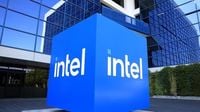On September 5, 2025, the U.S. government made headlines by acquiring a 9.9% equity stake in Intel, one of the nation’s most storied and strategically important semiconductor companies. The deal, worth $8.9 billion for 433.3 million shares at $20.47 each, marks a watershed moment not only for Intel but for American industrial policy, national security, and the broader debate over the role of government in the private sector. The move has triggered a fierce debate, exposed deep rifts within the Republican Party, and prompted questions about the future of U.S. technological sovereignty in an era dominated by artificial intelligence and global competition.
The government’s investment in Intel is structured as a passive stake. According to Intel’s own statement, the government will have no board representation or governance rights and has agreed to vote with the company’s Board of Directors. The funding for the purchase comes from $5.7 billion in grants under the CHIPS and Science Act and $3.2 billion from the Secure Enclave program. This brings the total government investment in Intel to $11.1 billion, when including previous CHIPS Act grants. Intel reaffirmed its commitment to delivering trusted and secure semiconductors to the U.S. Department of Defense as part of its Secure Enclave obligations.
President Donald Trump, who personally announced the deal, called it a “great deal” and suggested it was just the beginning of a new approach to industrial policy. When asked by a reporter if this represented a break with the Republican Party’s traditional support for free-market capitalism, Trump replied, “Yeah, it sure, it is. I want to try and get as much as I can.” He added, “The case of Intel was interesting, but I hope I’m going to have many more cases like it. Having the U.S. as a partner would be a very good thing for Intel.”
But the president’s enthusiasm has not been universally shared, especially among his own party. Kentucky Senator Rand Paul, a longtime advocate of small government, blasted the move as a “terrible idea.” On X, Paul wrote, “If socialism is government owning the means of production, wouldn’t the government owning part of Intel be a step toward socialism?” Retiring North Carolina Senator Thom Tillis went further, telling CBS News that the policy “starts feeling like a semi-state owned enterprise, à la CCCP,” referencing the Soviet Union. “You’re going to have to explain to me how this reconciles with free-market capitalism,” Tillis said.
Conservative commentator Erick Erickson echoed these concerns on his online show, calling the deal “actual socialism, happening by a Republican administration.” He argued, “We don’t have government control of Raytheon. We don’t have government control of Nvidia. We don’t have government control of Apple. We don’t have government control of Boeing. We don’t have government control of Lockheed Martin. … You want 10 percent control of Intel in exchange for money the government already promised to give them. … My God, people, what have we been fighting for for the last decade? You want smaller government. This expands it.”
The backlash is not limited to the right. California Governor Gavin Newsom, a potential 2028 presidential contender, seized on the Intel move to criticize Trump’s economic philosophy. “Trump has completely perverted capitalism. With his recent takeover of Intel, Trump has become the leading socialist of our time,” Newsom’s office posted on X. Days earlier, Newsom’s team shared an AI-generated image of Trump in front of the White House, flanked by Soviet-style flags, with the caption: “With his takeover of U.S. companies like Intel, this Labor Day America is praising CHAIRMAN TRUMP, our nation’s leading Socialist!!”
Despite the uproar, the administration frames the Intel investment as a strategic necessity. For years, the U.S. semiconductor industry operated under the assumption that market forces alone would sustain technological leadership. That era, it seems, is over. As semiconductors become the new geopolitical currency—vital for everything from AI to national defense—the government is stepping in as a co-investor, not just a regulator. The CHIPS and Science Act and Secure Enclave program have created a framework where the state guarantees Intel’s access to capital while avoiding direct governance interference.
This partnership model is significant. The government’s removal of claw-back and profit-sharing provisions from earlier CHIPS Act grants signals a shift from conditional handouts to a relationship prioritizing Intel’s financial flexibility. The company’s Arizona-based 3nm and 2nm fabrication plants are central to this strategy. By 2025, these facilities are expected to produce 18A node chips—1.8-nanometer breakthroughs that could power the next generation of AI workloads, quantum computing, and autonomous systems.
Intel’s recent product launches, such as the Xeon 6776P (now powering NVIDIA’s DGX B300 systems) and the upcoming Panther Lake processor, suggest incremental progress in catching up to rivals like AMD and Nvidia. However, Intel faces significant execution risks. Its manufacturing division is bleeding cash, and the company has had to lay off 15% of its workforce and shelve plans for new plants in Europe and Ohio. Still, as the only large-scale U.S.-based leading-edge chip manufacturer, Intel’s geopolitical significance cannot be overstated.
President Trump’s administration has also imposed a 100% tariff on imported semiconductors and is pushing for domestic AI infrastructure, further underscoring the national security imperatives behind the Intel investment. House Republicans have included provisions in the fiscal 2026 defense policy bill to restrict AI chip exports and support U.S. innovation, making clear that the government sees semiconductors as a strategic asset.
The Intel deal includes a clause that, should the company spin off its chip-making foundry business, the U.S. government could take an additional 5% stake—an incentive to keep AI chip production on U.S. soil. Treasury Secretary Scott Bessent told CNBC that converting Intel’s funding from the Biden-era CHIPS Act into equity was aimed at stabilizing the company’s U.S. manufacturing business.
Not everyone is convinced the government’s stake will pay off. Mark Tepper, CEO of Strategic Wealth Partners, questioned on X whether “the government should really be in the business of owning private companies,” noting Intel’s “inefficient operations, weak chips, no customers.” Peter Schiff, chief economist at Euro Pacific Asset Management, wrote, “If he wanted to be a businessman, he should have stayed in the private sector. Constitutionally, presidents are not elected to do business.”
Meanwhile, the American public remains skeptical. An Economist/YouGov poll released September 2, 2025, showed 53% of Americans disapproved of Trump’s handling of jobs and the economy, with 41% strongly disapproving. Trump’s overall job approval rating was similarly underwater, with 55% disapproving and 41% approving.
Yet, the stakes are undeniably high. As the U.S. faces increasing competition from China and seeks to decouple from foreign supply chains, Intel’s success or failure will have far-reaching implications. The government’s warrant for an additional 5% stake is a clear signal that it expects results. If Intel delivers on its 18A roadmap and maintains its foundry business, it could anchor the U.S. semiconductor supply chain for a generation. If not, the investment may become a cautionary tale of state intervention gone awry.
In the end, the government’s bet on Intel is more than a financial maneuver—it’s a declaration about the future of American technological power. Whether this gamble pays off remains to be seen, but for now, it’s a story that has shaken the foundations of U.S. economic policy and sparked a national conversation about the balance between free markets and strategic intervention.

